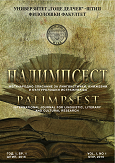RETEX AND GUERILLA DESIGN AS PROMOTERS OF SUSTAINABILITY
DOI:
https://doi.org/10.46763/PALIM24918173ntAbstract
Furniture design is a complex triangulation, balancing ergonomics, structure, and form. Guerilla furniture design builds upon these fundamental principles, layering in the use of salvaged materials and unconventional building techniques in the pursuit of inexpensive, sustainable solutions. The city is a fertile environment for the design guerilla, offering visual inspiration, cultural resources, and abundant foraging grounds. Like the reuse of existing buildings, guerilla design also uses existing materials for its designs. It's fascinating to see how guerilla furniture design incorporates salvaged materials and unconventional techniques to create sustainable and affordable solutions. This paper focuses on the results by the project ReTex, European project by the architect Ekaterina Namicheva Todorovska and fashion designer Aleksandra Jovanovska which are reusing existing materials and focusing on energy efficiency while promoting sustainability. Overall, ReTex stands as a testament to the power of design to create positive change and promote sustainability in everyday practices. By reimagining the potential of existing materials and transforming them into something new and innovative, we demonstrate the value of conscious design choices in fostering a more sustainable future.
Keywords: guerilla design; textile reuse; furniture design; chair redesign; sustainability; salvaged materials.


